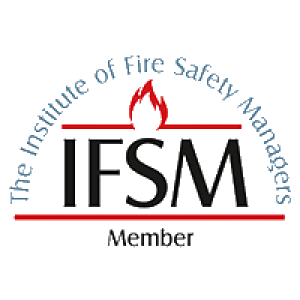Churches and historic places of worship present unique fire safety challenges that most other buildings simply don’t face.
These centuries-old structures, with their timber frames, stone walls, and irreplaceable artefacts, need specialised approaches to fire prevention and electrical safety.
Recent guidance from major church insurers shows both the extent of these challenges and practical ways to manage fire risk in these special buildings.
Understanding the Challenge
Fire remains one of the most serious threats to churches, potentially causing devastating damage to buildings whilst also putting congregations and visitors at risk.
Comprehensive guidance from Ecclesiastical Insurance Office and Methodist Insurance shows that electrical faults are amongst the leading causes of church fires, alongside heating systems and arson attacks.
The statistics are quite sobering.
Churches are roughly five times more likely to suffer structural damage from lightning strikes without proper protection systems, whilst around 60% of lightning-related insurance claims involve damage to electrical wiring and equipment rather than structural damage itself.
This really highlights how vulnerable electrical systems can be in these historic buildings.
What the Law Requires of Churches
The Regulatory Reform (Fire Safety) Order 2005 completely changed fire safety obligations for all premises, including churches. Under this legislation, a “Responsible Person” – usually the Managing Trustees, Diaconate, or whoever has overall management control – must carry out thorough fire risk assessments regardless of whether the church employs any staff.
This marked a significant change from earlier legislation.
As Baptist Insurance’s fire risk assessment template makes clear, “We are required to undertake a Fire Risk Assessment… even if we have no employees.” The assessment must cover ignition sources, detection systems, escape routes, firefighting equipment, and how fire might affect neighbouring premises.
The responsibility goes well beyond simple compliance.
Methodist Insurance’s guidance emphasises that Managing Trustees must appoint “one or more Competent Persons” with appropriate qualifications, knowledge, and experience to help implement protective measures. This isn’t just about ticking boxes – it’s about creating reliable systems that can prevent tragedies.
Electrical Safety: The Hidden Risk
Faulty electrical installations pose a major fire risk in churches, even with today’s improved installation standards. The guidance reveals several critical areas that church leaders often miss.
Fixed Electrical Systems
All churches must have their electrical installations inspected and tested every five years by contractors with full scope registration from recognised bodies including the National Inspection Council for Electrical Installation Contracting (NICEIC), The Electrical Contractors Association (ECA), or The National Association of Professional Inspectors and Testers (NAPIT). Importantly, electricians registered only for domestic work under Part P of the Building Regulations aren’t suitable for church installations.
Methodist Insurance’s guidance stresses that “only electrical contractors with ‘Full Scope’ registration… should be employed.” This requirement reflects how complex church electrical systems can be, often combining historic wiring with modern needs for lighting, sound systems, and heating controls.
Organs: A Special Concern
Church organs create unique electrical challenges that need specialist attention. Methodist Insurance identifies organs as a particular “danger area,” noting that organ lights, whether for illuminating keyboards or internal inspection, must be installed by qualified electricians using permanent wiring rather than temporary solutions.
The guidance recommends that maintenance lights should be non-heat producing fluorescent types, positioned above each section of pipework.
Portable electric heaters for organists should be convector or fan-assisted types with thermostatic cut-outs, and crucially, “the plug should always be disconnected from the socket at the end of each service.”
Regular professional inspection by experienced organ builders is essential, as tuners may lack the detailed technical knowledge needed to spot electrical dangers in complex organ circuitry.
The electric organ blower, often overlooked, needs examination by qualified electricians at regular intervals, whilst humidifying equipment should have maintenance contracts with six-monthly inspections.
Portable Appliance Testing
The growing use of portable electrical equipment in churches – from projectors and sound systems to kettles and heaters – creates additional fire risks.
All portable appliances must be maintained safely, with legal requirements under the Electricity at Work Regulations 1989 and the Provision and Use of Work Equipment Regulations 1998.
Churches must establish systematic testing programmes for all portable electrical appliances, including those belonging to outside groups using church facilities.
The frequency should reflect usage levels and how harsh the working environment is, with visual inspections needed before each use to check for damaged plugs, frayed cables, and loose connections.
Putting Fire Risk Assessment into Practice
The fire risk assessment process involves two key stages: identifying existing hazards and determining what changes are needed to safety arrangements. Baptist Insurance’s comprehensive template breaks this down into manageable sections covering building details, potential hazards, protection arrangements, and action planning.
Spotting Hazards
The assessment must examine various potential ignition sources. Electrical hazards go beyond fixed installations to include portable heaters, which should be thermostatically controlled electric units positioned well away from combustible materials. The guidance warns against portable LPG heaters because of their moisture production, which can seriously damage building fabric and accelerate timber rot.
Heating systems present particular challenges in historic buildings. Gas installations need annual servicing by Gas Safe registered installers, whilst oil-fired systems require OFTEC registered engineers. Solid fuel systems, including wood-burning stoves and fireplaces, need annual chimney sweeping by competent professionals, preferably members of The Guild of Master Chimney Sweeps or HETAS approved sweeps.
The Arson Risk
Churches face heightened arson risks because of their isolated locations, limited security, and symbolic significance. The guidance identifies key risk factors including availability of combustible materials, inadequate lighting, poor perimeter security, and the church’s occupation or political context.
Effective arson prevention needs systematic risk assessment considering the building’s vulnerability to malicious attack. This includes securing waste storage arrangements, improving lighting and physical security, and ensuring adequate intruder alarm systems. The psychology of arson – often driven by revenge, substance abuse, mental health problems, or attempts to conceal other crimes – makes prevention particularly challenging.
Protection Systems and Equipment
Effective fire protection needs layered systems combining detection, suppression, and evacuation capabilities. The guidance shows significant variations in approach depending on building size, usage patterns, and risk levels.
Detection Systems
Whilst not all churches need automatic fire detection systems, those with complex layouts or periods when they’re unoccupied should consider BS 5839 Part 1 compliant installations. Systems should be designed, installed, and maintained by LPS 1014 certified firms or BAFE accredited installers, with annual maintenance contracts essential.
For churches choosing simpler manual alarm systems, the guidance suggests alternatives ranging from rotary gongs to break-glass panels. However, many smaller churches rely on stewards shouting “Fire!” – an approach that needs careful training and clear procedures.
Fire Extinguishers
Portable fire extinguishers represent the first line of defence against small fires. The guidance recommends one 9-litre water extinguisher for each 200 square metres of floor area, with minimum provision of two extinguishers including water and carbon dioxide types.
Extinguisher placement needs careful consideration. They should be mounted at prominent positions near exits, with the carrying handle 1 metre above floor level. For organs, carbon dioxide extinguishers should be positioned close to the instrument, whilst kitchens need wet chemical extinguishers and fire blankets.
Crucially, dry powder extinguishers are unsuitable for church interiors because of their corrosive and abrasive properties, which can cause “considerable damage to the building fabric and contents.” This restriction reflects the need to balance fire suppression with heritage preservation.
Managing Construction and Maintenance Risks
Building work creates elevated fire risks that need specialised management approaches. Methodist Insurance emphasises that “there is a serious danger of fire or accident when works of repair or restoration are in progress,” requiring close supervision by Managing Trustees.
Hot Work Permits
Any work involving welding, cutting, or other heat-generating processes needs formal hot work permit systems. These must be issued by nominated fire safety officers with appropriate training, covering specific tasks in clearly identified areas for limited periods.
The permit process includes comprehensive checklists ensuring fire protection measures are adequate, suitable extinguishers are available, and trained personnel provide continuous fire watch during work and for at least one hour afterwards. This systematic approach helps prevent the construction-related fires that have devastated numerous historic buildings.
Managing Contractors
External contractors need careful control, with clear requirements for public and employers’ liability insurance extending to protect church interests. For major works exceeding £1 million, Methodist Insurance requires compliance with the Joint Code of Practice on Protection from Fire of Construction Sites and Buildings Undergoing Renovation.
Daily inspections by responsible church officials are essential, with particular attention to waste removal, temporary electrical installations, and smoking controls. The guidance recommends irregular daytime visits alongside end-of-day inspections to maintain vigilance throughout construction periods.
Modern Risks and Contemporary Challenges
Today’s church activities introduce new fire risks that need updated assessment approaches. The guidance highlights several emerging concerns that traditional risk assessments might miss.
Modern Equipment
Three-dimensional printing equipment, laser cutters, and advanced audiovisual systems create novel fire hazards. Laser cutters pose particular risks because of high-temperature operations and flammable vapour production, requiring metal extract ducting and constant supervision. The guidance explicitly states that laser cutters “should not be left running whilst unattended.”
Workshop activities including woodworking, welding, and use of flammable liquids need specialised controls. Wood shavings must be disposed of in lidded metal bins, whilst welding operations need trained operators, nearby fire extinguishers, and removal or screening of combustible materials.
Candlelit Services
Candles present obvious fire risks that need careful management. The guidance recommends good quality, slow-burning candles in metal holders on non-combustible surfaces, positioned well clear of foliage, decorations, and electrical equipment.
Hand-held candles need particular attention, especially with children present. Purpose-made candles with slide-on drip trays should be used, with proper supervision to prevent overcrowding and ensure adequate separation between participants. The risk of igniting clothing or hair makes this area particularly sensitive.
Lightning Protection and Surge Damage
Churches’ elevated positions and metal fixtures make them natural lightning targets. Whilst lightning conductors can actually increase strike likelihood, they provide controlled discharge paths preventing structural damage.
Modern systems should comply with BS EN 62305, replacing the older BS 6651 standard. The new regulations require inspection every four years maximum, though the guidance suggests aligning with quinquennial inspection cycles. Visual inspections by church officers should occur annually.
Lightning damage increasingly affects electronic systems rather than building structures. Surge protection devices protecting alarms, computers, telephones, and electronic organs need specialist installation following BS 7671 requirements. The guidance emphasises consulting specialists before installation, as inappropriate surge protection can create additional hazards.
Moving Forward
Effective fire safety in churches needs balancing heritage preservation with contemporary safety standards. The guidance demonstrates that this balance is entirely achievable through systematic risk assessment, appropriate technology selection, and ongoing maintenance programmes.
The key lies in understanding that fire safety isn’t about transforming historic buildings into modern facilities, but rather about implementing proportionate measures that reduce risk without compromising architectural or spiritual integrity. As Baptist Insurance notes in their risk assessment template, fire safety arrangements should be “common sense and in the main, not expensive.”
Church leaders need to move beyond viewing fire safety as regulatory compliance towards embracing it as stewardship of irreplaceable heritage and community safety. The comprehensive guidance now available provides practical frameworks for achieving this goal, but success requires sustained commitment to implementation and ongoing review.
The stakes are simply too high for complacency. When fire strikes churches, the losses extend far beyond insurance valuations to encompass centuries of history, community identity, and spiritual significance. Proper fire risk assessment and electrical safety management represent essential investments in preserving these sacred spaces for future generations.
The documentation reviewed reveals that effective church fire safety is entirely achievable through systematic application of established principles. The question isn’t whether churches can afford to implement comprehensive fire safety measures, but whether they can afford not to do so.










